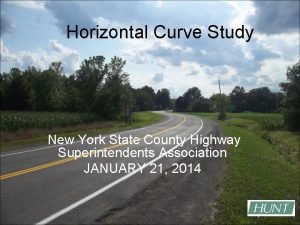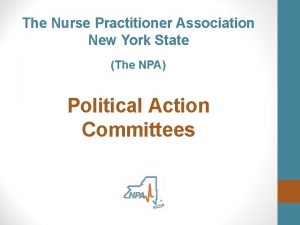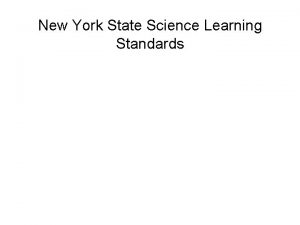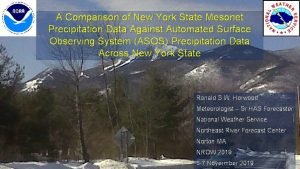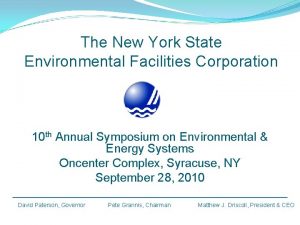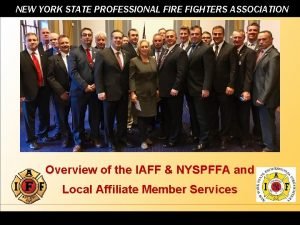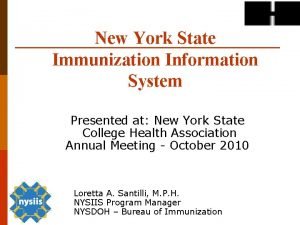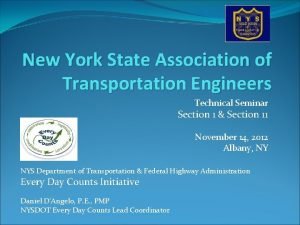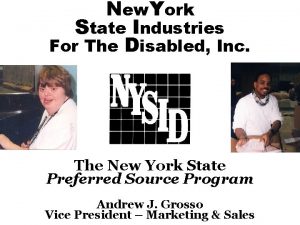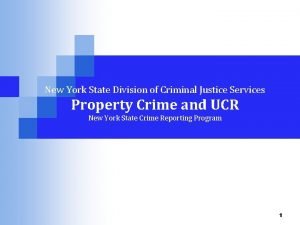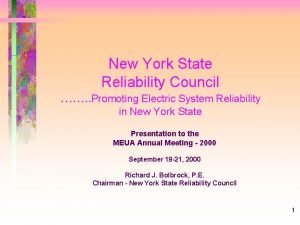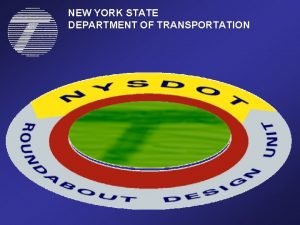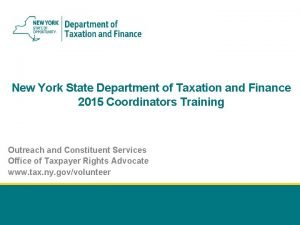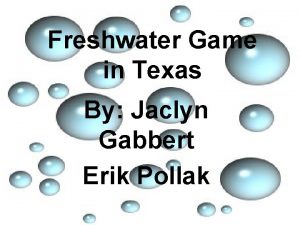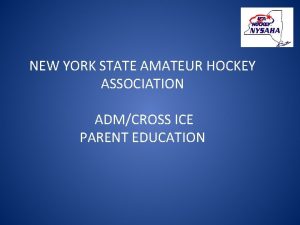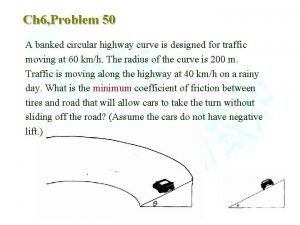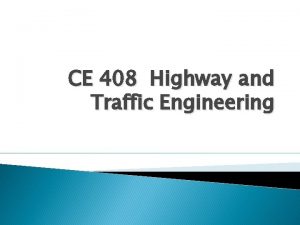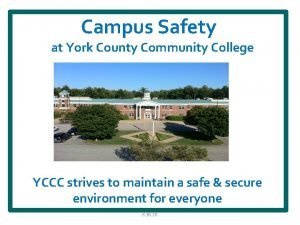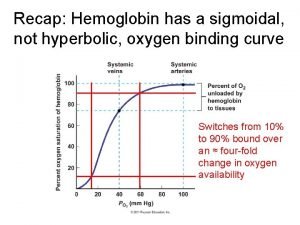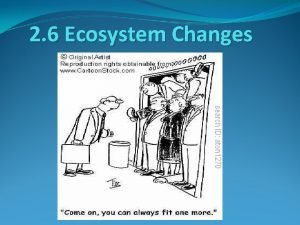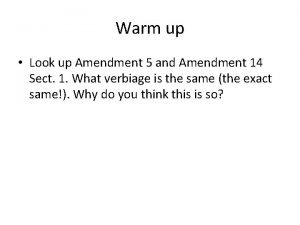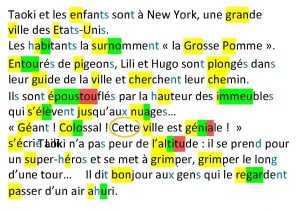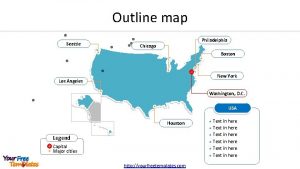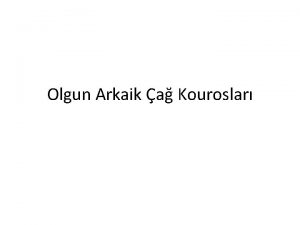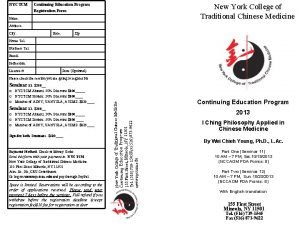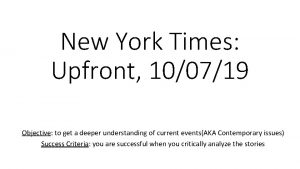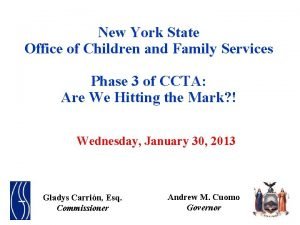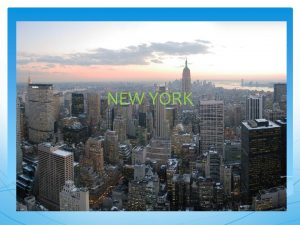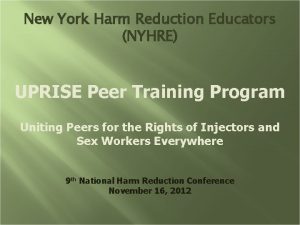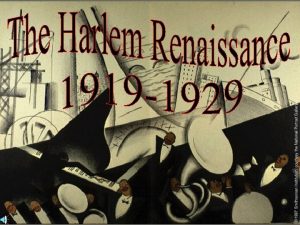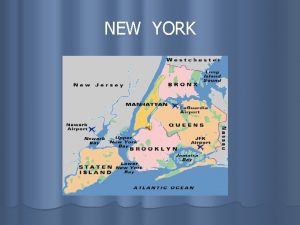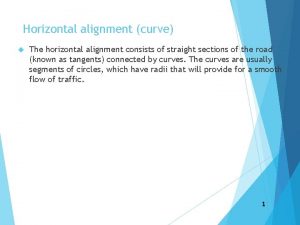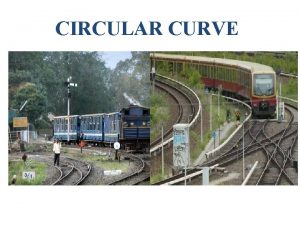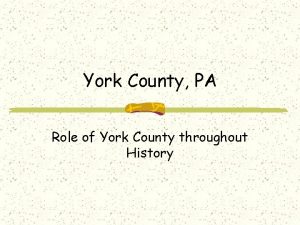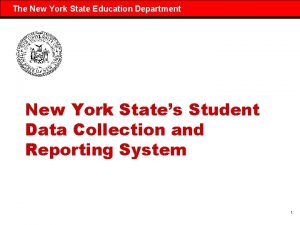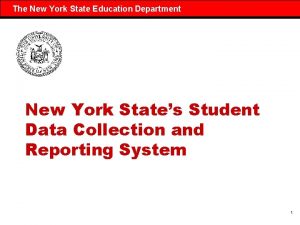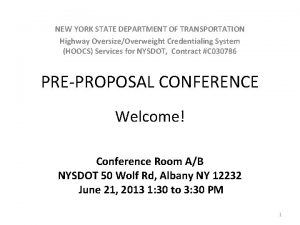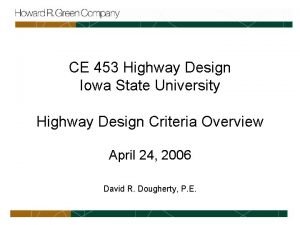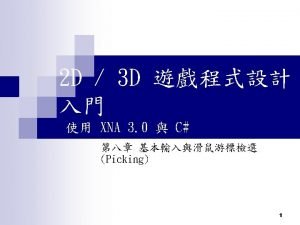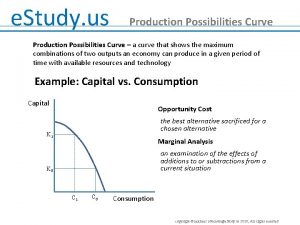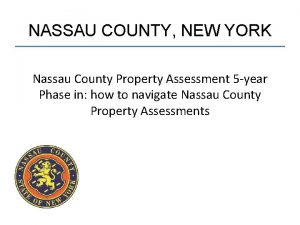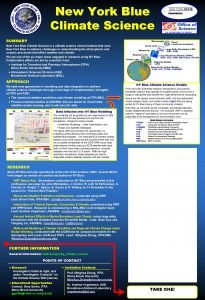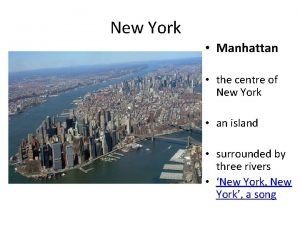Horizontal Curve Study New York State County Highway




















































- Slides: 52

Horizontal Curve Study New York State County Highway Superintendents Association JANUARY 21, 2014

Reasons for MCDOT Study • The 2009 NMUTCD changed the criteria for horizontal alignment signs, requiring signs to be added, removed, modified, and the location of the sign has been adjusted in relation to the curve. • The previous Ball Bank Indicator standards were out of date. New standards have been established which bring recommended advisory speeds more in line with today’s vehicles, tires and overall vehicle and roadway designs. • Current advisory speeds are ignored, creating a safety issue for the vehicle operator. If advisory speed is too low, motorists freely increase speed at a dangerous acceleration rate and causes an accident by either head-on collision or leaving the roadway and crashing into a fixed object. • HUNT Engineers, Architects & Land Surveyor, P. C. was selected by MCDOT to provide the engineering services to complete the Horizontal Curve Study to evaluate all of the horizontal curves (more than 600) within their jurisdiction and identify necessary changes. • MCDOT received funding through the Unified Planning Work Program (UPWP) to have the study completed.

History • Travel ways were originally built to accommodate the walker and horse rider • Gradually paths were improved to accommodate horse-drawn carriages and wagons • Finally, motor vehicles were introduced

Vehicle History • 1815 – 1915 Horse-drawn carriages were main mode of transportation • 1900’s motorized vehicles appear where the top speed was 25 mph

Vehicle History • 1920’s Mass Vehicle Production Begins • Top Speed Increase to between 40 to 50 mph • Highway fatalities tripled from 10, 723 in 1918 to 31, 215 in 1929

Early Highway Design • “Roadways” were merely widened pathways • Roadways generally matched the existing terrain • On roadway, Vehicle speed was generally as fast as the vehicle would go

Early Highway Design • Driver was expected to slow down when approaching a curved section based on experience

Superelevation • Early road design engineers in the 1920’s & 30’s were railroad workers • Workers knew one track was higher than the other on curves

Superelevation • This same principal was applied to roadways and is now known as superelevation. R= V² 15 (0. 01 e+f) NYSDOT Section 5. 7. 3. 1 Basic Horizontal Curve Calculation

Superelevation • Superelevation is the banking of the traveled way cross slope to counter the centripetal forces of a vehicle traveling around a curve. R= V² 15(0. 01 e+a/g) NYSDOT Section 5. 7. 3. 2 Horizontal Curve Design to Avoid Rollover Crashes

Speed/Curve Correlation • There were many disagreements between world reknowned people on procedures for determining safe speeds • In 1935, The Bureau of Public Roads (BPR) began research testing of safe driving speeds on curves • BPR issued instructions for measuring curvature and superelevation

Bureau of Public Roads History Department of Agriculture • • • Office of Road Inquiry 1893 -1899 Office of Public Road Inquiries 1899 -1905 Office of Public Roads 1905 -1915 Office of Public Roads and Rural Engineering 1915 -1918 Bureau of Public Roads (1918 -1939) Federal Works Agency • Public Roads Administration, PRA 1939 -1949 Transfers • Dept. of Commerce, August 20, 1949; to Federal Highway Administration, DOT April 1, 1967, by Dept of Trans. Act October 15, 1966

Bureau of Public Roads History Abolished • Functions absorbed by Federal Highway Administration August 10, 1970 Successor Agency = Federal Highway Administration (FHWA)

Speed/Curve Correlation • The Bureau put out an invitation for experimental testing to the public • 900 Roads and Several hundred volunteers participated from various states • Vehicle size, model, weight, or tires were not considered when the study was completed Ex. From 1903 -1929 Ford, Tire width between 3 and 6 inches, Weight between 1, 200 and 2, 495 lbs.

Speed/Curve Correlation • No driver descriptions were reported • All ages, any driving experience, capabilities were accepted • Different pavement surfaces were not considered • Dirt/Gravel, Asphalt, Concrete Dirt Road curve Asphalt Road curve

Speed/Curve Correlation • The range of friction factors based on the Bureau of Public Roads study were from 0. 07 to 0. 20. • An average side friction factor of 0. 16 for speeds between 20 and 60 mph was a result of the study using the basic side friction formula: E + F = 0. 67 V²/R, E = Superelevation, F = Side Friction Factor, V = Velocity in MPH, R = Radius in ft.

Ball Bank Indicator in the late 30’s • 1937 Missouri State Highway Department began experimenting based on the Bureau of Public Roads research. • They determined that a 10° ball-bank reading corresponded to a side friction of about 0. 14 – 0. 15 Most common Ball Bank Indicator used

1940’s Testing • Iowa engineering experiment of 1940, wide range of speeds and degree of curves • General Motors proving ground to determine effects of body roll on closed tracks • Illinois Division of Highways tested on smooth pavement, slightly rough pavement and rough pavement • Rough to Slightly rough surfaces caused computed safe speeds to be underestimated • While smoother pavements generally caused safe speeds to be overestimated

Highway Policy • 1937 to 1944 AASHO, special committee published seven motor vehicle design policies – – – – Highway Classification Geometric Highway Types Sight Distance on Highways Marking and Signing of no-passing zones Intersections and Grades Rotary Intersection Grade Separations • August 1, 1954 the committee combined policies into one manual called A Policy on Geometric Design of Rural Highways • 1965 AASHO and 1984 AASHTO incorporated these policies which included the BBI standards

Studies Completed to date by HUNT

Report That Changed Criteria • FHWA –SA-11 -22 • This report was completed by the following • Brudis & Associates, Inc. • Science Applications International Corporation • Texas Transportation Institute

Placement of Warning Signs Section Changes • Section 2 C. 05 Placement of Warning Signs of the 2009 NMUTCD removed and Replaced in its entirety by Section 2 C. 05 of the NYS Supplement to the NMUTCD • Advanced sign placement distance changes • 2009 NMUTCD distance determined by the following: • • • 2. 5 second PRT (Perception of Reaction Time) 10 feet/second² Minus the sign legibility distance of 250 ft • NYS Supplement distances determine by the following: • • 2. 5 second PRT 10 feet/second² • Removal of sign legibility distance • NYSDOT has interpreted the NMUTCD to indicate that a “should” is essentially a “shall” unless you have a valid engineering reason to do it not

Placement of Warning Signs Section Changes Table shown above is from the 2009 NMUTCD

Placement of Warning Signs Section Changes Table shown above is from the New York State Supplement

Horizontal Alignment Section Changes • Section 2 C. 07 Horizontal Alignment Signs of the 2009 NMUTCD removed and replaced in its entirety by Section 2 C. 07 of the NYS Supplement to the NMUTCD • Section was greatly expanded by the supplement • Highlights of the changes are as follows: • If Table 2 C-5 indicates that a horizontal alignment sign is required, recommended, or allowed, the sign installed in advance of the curve shall be a Curve (W 1 -2) sign unless a different sign is required, recommended, or allowed by the provisions of this Section (S) • A Turn (W 1 -1) sign shall be used instead of a Curve sign in advance of curves that have advisory speeds of 30 mph or less (S) • Where the legal speed limit is 30 mph and the advisory speed is higher than the speed limit, a horizontal sign, if used, may be either a Turn (W 1 -1) or Curve (W 1 -2) sign (O) Legend O=Optional G=Guidance S=Standard

Horizontal Alignment Section Changes • Where the advisory speed is less than the legal speed limits, the horizontal alignment sign shall be supplemented with an advisory speed plaque (S) • Where the advisory speed is greater than the legal speed limit, an advisory speed plaque shall not be used (S) • Where the advisory speed is equal to the speed limit, an advisory speed plaque may be used (O) Legend O=Optional S=Standard

Horizontal Alignment Section Changes • Section 2 C. 07. 00 J Curves in the same direction separated by 200 ft or more shall be signed separately (part 1) • Section 2 C. 07. 00 J Curves in opposite directions separated by 600 ft or more shall be signed separately (part 2)

Horizontal Alignment Section Changes • Section 2 C. 07. 00 J – Example, “S” curve separated by 600 ft leads into a curve that is more than 600 ft between curves • Section 2 C. 07. 00 K – Two curves in the same direction separated by less than 200 ft may be considered a single curve having an advisory speed equal to the lower of the two curves

Horizontal Alignment Section Changes • Highlights continued • Separate signing of two curves in opposite directions, by 600 ft or less is preferred, Separate signing of two curves separated by 400 ft may also be preferred. (SP) • The winding road sign may be used where warning is required for a series of three or more curves, generally alternating in direction and separated by distances of 600 ft or less (O) • Advisory speed plaque used in a series of curves shall be the lowest speed of any curve in the series. (S) • Distance Plaque (W 16 -4 p) may be used in a series of curves stating the distance to the end of the series of curves (O) Legend O=Optional S=Standard SP= Support

Horizontal Alignment Section Changes • Section 2 C. 07. 00 R Within a series of curves where a W 1 -5 curve sign is used, an appropriate Turn, Curve, Reverse Turn or Curve sign may be used for individual curves or curve combinations having advisory speeds significantly lower than the other curves (G) W 1 -5 L/W 13 -1 p What does this mean? W 1 -1 L/W 13 -1 p W 1 -1 R/W 13 -1 p A warning sign can be placed within a series of curves as shown W 1 -5 L/W 13 -1 p Legend G=Guidance

Chevron Usage and Placement Table from 2009 NMUTCD does not completely reflect the NYS Supplement changes • Chevron Placement • Difference between posted speed and advisory speed determines chevron placement • Difference of 15 mph or more – Chevrons are required • Difference of 10 mph or more – Chevrons are recommended • Difference of 5 mph – Chevrons are optional

Horizontal Alignment Warning Sign • Section 2 C. 06 Horizontal Alignment Warning Signs • 2 C. 06. 02 In advance of horizontal curves on freeways, expressways or roadways with more than 1, 000 AADT that are functionally classified as arterials or collectors, horizontal warning signs shall be used in accordance with table 2 C-5 (S) • 2 C. 06. 03 Horizontal Alignment Warning Signs may also be used on other roadways or on arterial and collector roadways with less than 1, 000 AADT based on engineering judgment (O) Legend S=Standard O=Optional

Advisory Speed Plaque Changes • Section 2 C. 08 Advisory Speed Plaque of the 2009 NMUTCD revised by Section 2 C. 08 of the NYS Supplement to the NMUTCD • Section changes were major to the BBI study • NYS Supplement changes to the section were minor • Basically, the supplement states that an advisory speed plaque shall be used where the advisory speed is below the legal speed limit. (This is the most significant change in table 2 C-5)

Ball Bank Indicator • Ball Bank Indicator – A ball bank indicator is used to measure the combined effect of forces acting on a vehicle as it travels through a horizontal curve. It measures the angular deflection of a free moving ball from the vertical axis of the vehicle body. • Shown in this picture is HUNT’s (Reiker RDS-BB 09) Electronic Ball Bank Indicator hooked up to a lap top • BBI takes readings every 250 ms

AASHTO Accepted BBI Readings • Up until March 16, 2011 NYSDOT performed a calculation of the speed using the curve radius, superelevation and the simplified curve formula from AASHTO 2004 Manual, using a side friction factor as their basis in determining the advisory speed standards. This translated into the following

Ball Bank Readings as Previously Accepted by NYSDOT • Ball Bank Readings • • 16 Degrees for speeds up to 24 mph 14 Degrees for speed of 25 to 34 mph 12 Degrees for speeds of 35 and 49 mph 10 Degrees for Speeds of 50 mph or more • These Ball Bank Indicators were formerly used in determining advisory speeds based on research from the mid 1930’s

NYSDOT Accepts FHWA BBI Standards • NYSDOT now accepts the standards as set forth by FHWA which are as follows: • • • 16 Degrees of Ball Bank for speeds of 20 mph or less 14 Degrees of Ball Bank for speeds of 25 to 30 mph 12 Degrees of Ball Bank for speeds of 35 mph and higher • Sample Field Worksheet

Procedures to Establish New Advisory Speed • Data collection is completed during favorable weather only, no data was collected while raining or during peak rush hour times • First Step, determine what the existing warning sign(s) are on the curve(s) • Type of warning sign(s), W 1 -1, W 1 -2 etc. • Advisory Speed Plaque W 13 -1 p • Next, complete the first trial run at the posted advisory speed if one exists. If none exists, then trial is completed at the posted speed limit

Procedures to Establish New Advisory Speed • The next step is to determine if there will be an increase or decrease in advisory speed. (mostly increase) • Trial will be completed at 5 mph increments until new advisory speed is determined • Once new advisory speed is determined three trials are completed at the new advisory speed to insure accuracy of the established advisory speed.

Sign Selection Process • Sign selection is based on BBI reading vs advisory speed vs speed limit. • Example Existing Speed Limit Existing Signage W 1 -2 L/W 13 -1 p BBI Readings 35 mph = 3. 57° Existing Advisory Speed 40 mph = 5. 95° 45 mph = 8. 48° 50 mph = 11. 02° New Advisory Speed 50 mph = 11. 29° 50 mph = 11. 18° 55 mph = 14. 23º BBI Criteria • 16 Degrees of Ball Bank for speeds of 20 mph or less • 14 Degrees of Ball Bank for speeds of 25 to 30 mph • 12 Degrees of Ball Bank for speeds of 35 mph and higher

Sign Selection Process • Based on the BBI reading of 11. 29° at 50 mph and > 12º at 55 mph, the proper signs for this situation would be the following: W 1 -2 L/W 13 -1 p

Sign Placement Requirements W 1 -1 W 1 -2 W 1 -3 W 1 -4 W 1 -1 & W 1 -3 signs are placed when the advisory speed is 30 mph or less, (BBI Reading up to 14 degrees) regardless of speed limit, unless the speed limit and advisory speeds match, then the signs are optional W 1 -2 & W 1 -4 signs are placed when the advisory speed is 35 mph or more, (BBI Reading up to 12 degrees) regardless of speed limit, unless the speed limit and advisory speeds match, then the signs are optional

Chevron/Arrow Sign Placement Requirements W 1 -6 W 1 -8 Placement of W 1 -6 & W 1 -8 signs are based on the difference between the Posted Speed Limit and the Advisory Speed. They should be used whenever advisory speed is 10 mph or more below the posted speed limit. They are optional and may be used if advisory speed is 5 mph less than the posted speed limit.

Examples from Study Speed Increase Example Speed Decrease Example

Typical Town Summary from MCDOT Study Summary Example

Typical Town Summary from MCDOT Study Summary Example

Typical Town Summary from MCDOT Study Summary Example

Typical Reduced Town Summary from MCDOT Study Reduced Summary Example

Quiz Time 1) 2) 3) 4) 5) In what year did the BPR begin research testing? 1935 Which state was the first to begin experimental testing? And in what year? Missouri 1937 What motor company did independent testing on closed tracks? General Motors If two curves in the same direction are separated by less than 200 ft, would you sign the curves separately or as one curve? Signed as one curve What is the maximum tangent distance between two curves in opposite directions, before separate signing is required? 600 ft

Quiz Time, continued 6) What is the minimum tangent distance between curves in opposite directions before separate signing is an option? 400 ft 7) When completing a series of curves in a ball bank run, what is the controlling factor to determining the advisory speed? Lowest Advisory Speed 8) If your speed is limit is 30 mph and your advisory speed is 30 mph what sign is used? None, not required 9) If your Ball Bank Indicator reading was 13° @ 25 mph, what sign shall be used? W 1 -1 10) What is the difference in between posted speed and advisory speed before an advisory speed plaque is required in NYS? 5 mph

References • Safe Speeds on Curves: A Historical Perspective of the Ball Bank Indicator, ITE Journal September 1988 By: David R. Merritt • FHWA Safety Program, Procedures for Setting Advisory Speeds on Curves, FHWA-SA-11 -22, June 2011 • 2009 National Manual on Uniform Traffic Control Devices and all addenda • NYS Supplement to the 2009 NMUTCD, Dated March 16, 2011 • National Archives (Record Group 30) 1892 -1972 Records of the Bureau of Public Roads • Initial Design Standards for the Interstate System, By Jerry Hall and Loretta Hall

Questions & Contact Info • Earl Bailey HUNT Engineers, Architects & Land Surveyors, PC 4 Commercial Street, Suite 300 Rochester, NY 14614 Ph: 585 -327 -7950 x 218 Email: baileye@hunt-eas. com • Brent Penwarden III Monroe County DOT 6100 City Place 50 W. Main Street Rochester, NY 14614 Ph: 585 -753 -7733 Email: Bpenwarden@monroecounty. gov
 New york state county highway superintendents association
New york state county highway superintendents association New york nurse practitioner association
New york nurse practitioner association New york state tap
New york state tap New york state teacher certification examinations
New york state teacher certification examinations New york state standards science
New york state standards science Math state test 2018 answer key
Math state test 2018 answer key New york mesonet
New york mesonet New york state vegetable
New york state vegetable Nys environmental facilities corporation
Nys environmental facilities corporation New york state professional firefighters association
New york state professional firefighters association What is nysiis
What is nysiis New york state association of transportation engineers
New york state association of transportation engineers Nysid catalog
Nysid catalog Department of criminal justice services ny
Department of criminal justice services ny New york state reliability council
New york state reliability council How many roundabouts in new york
How many roundabouts in new york Nytprin
Nytprin Nys rn scope of practice
Nys rn scope of practice New york state fish
New york state fish New york state nickname
New york state nickname New york state medicaid prior authorization
New york state medicaid prior authorization New york state amateur hockey association
New york state amateur hockey association New york, new jersey, pennsylvania, and delaware
New york, new jersey, pennsylvania, and delaware Orchard 14 marquee cinema
Orchard 14 marquee cinema Both new hampshire and new york desire more territory
Both new hampshire and new york desire more territory Both new hampshire and new york desire more territory
Both new hampshire and new york desire more territory A banked circular highway curve is designed
A banked circular highway curve is designed Ashland county wi gis
Ashland county wi gis Ce 408
Ce 408 M.p. state highway act
M.p. state highway act York county community college pa
York county community college pa Student accommodation university of york
Student accommodation university of york Hill coefficient less than 1
Hill coefficient less than 1 S curve and j curve
S curve and j curve Bilateral balanced occlusion definition
Bilateral balanced occlusion definition S curve and j curve
S curve and j curve Barbara pacher
Barbara pacher Procedural vs substantive due process
Procedural vs substantive due process Merriweather library
Merriweather library What is halfway between east egg and new york
What is halfway between east egg and new york Not laughing out loud candy
Not laughing out loud candy Taoki à new york
Taoki à new york Philadelphia map outline
Philadelphia map outline Volomandra
Volomandra Ny college of traditional chinese medicine
Ny college of traditional chinese medicine New york times upfront
New york times upfront Ccta new york
Ccta new york Lega new yorka
Lega new yorka New york harm reduction educators
New york harm reduction educators Zone di new york
Zone di new york Harlem 1920s map
Harlem 1920s map Nysalm
Nysalm Leotrace
Leotrace
